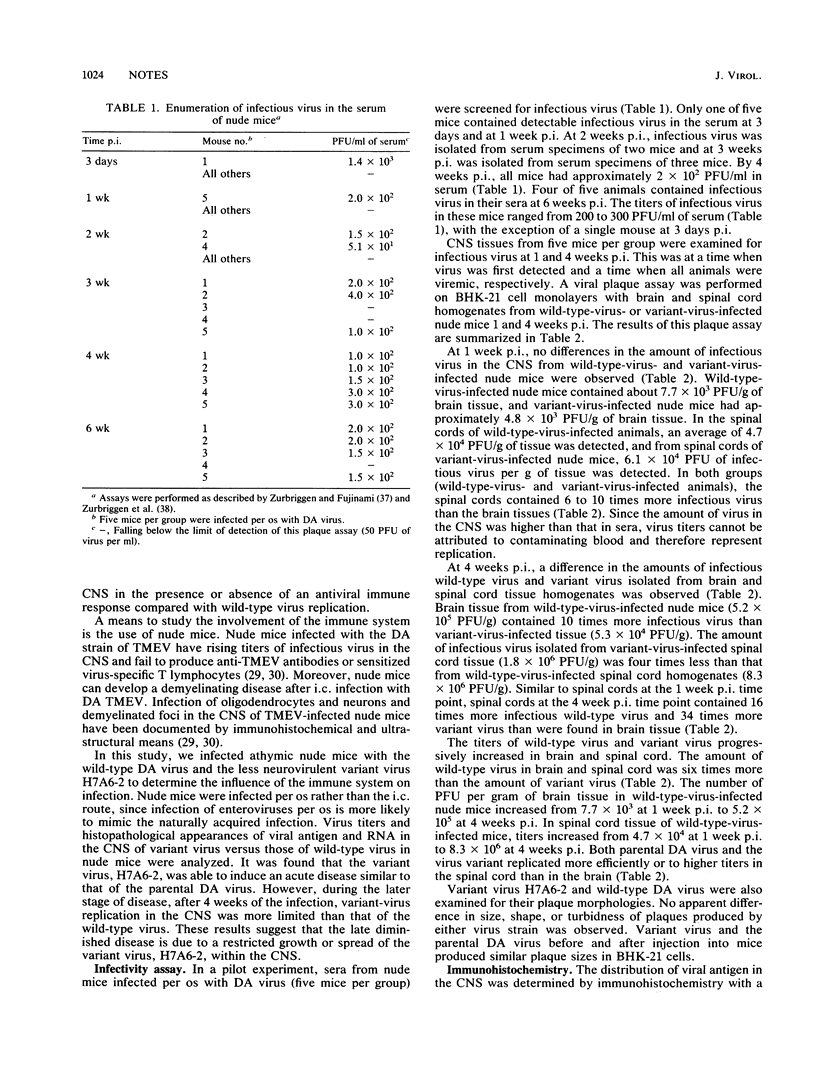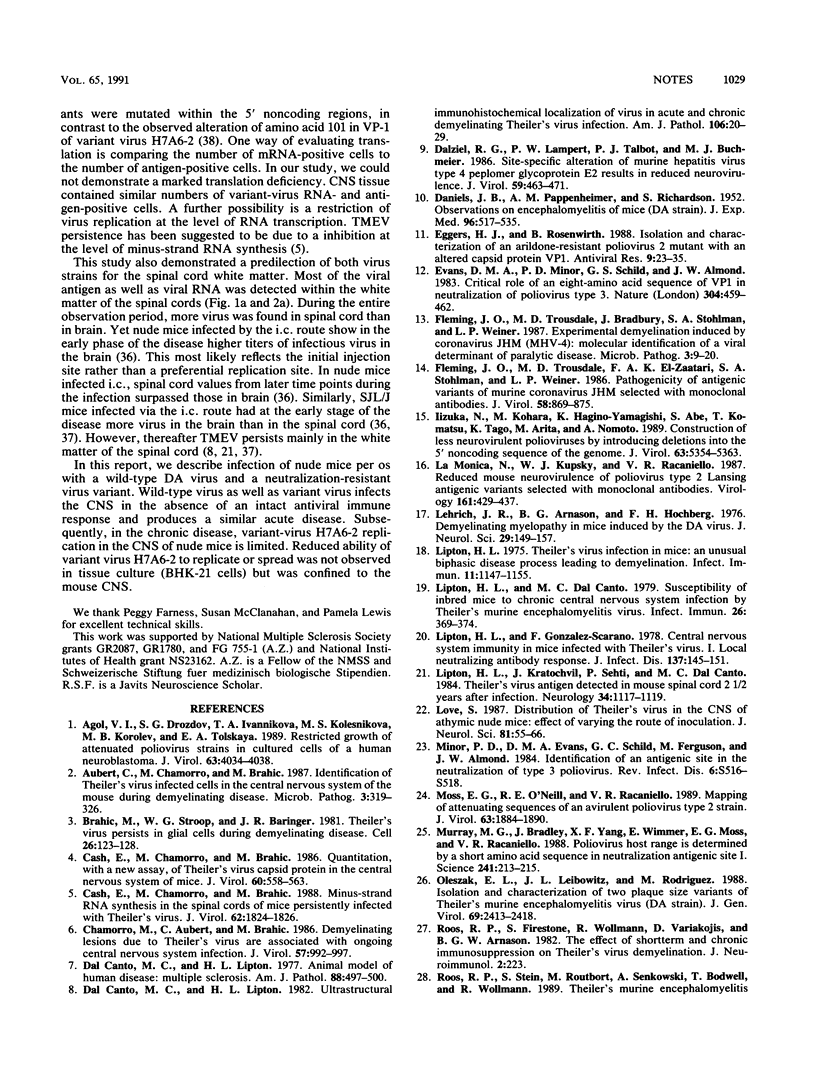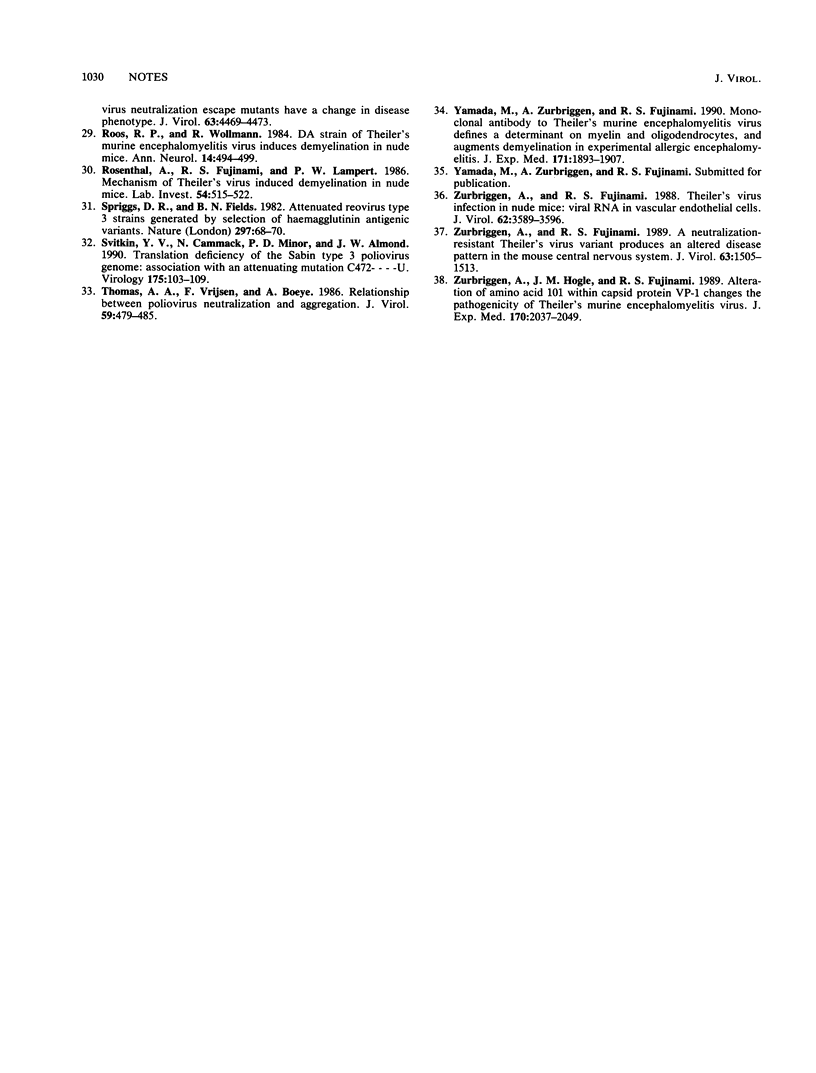Abstract
The Daniels strain of Theiler's murine encephalomyelitis produces a chronic disease which is an animal model for human demyelinating disorders. Previously, we selected a neutralization-resistant virus variant producing an altered and diminished central nervous system disease in immunocompetent mice which was evident during the later stage of infection (after 4 weeks) (A. Zurbriggen and R. S. Fujinami, J. Virol. 63:1505-1513, 1989). The exact epitope determining neurovirulence was precisely mapped to a capsid protein, VP-1, and represents a neutralizing region (A. Zurbriggen, J. M. Hogle, and R. S. Fujinami, J. Exp. Med. 170:2037-2049, 1989). Here, we present experiments with immunoincompetent animals to determine viral replication, spread, and targeting to the central nervous system in the absence of detectable antibodies or functional T cells. Nude mice were infected orally, and the virus was monitored by plaque assay, immunohistochemistry, and in situ hybridization. Early during the infection (1 week), the variant virus induced an acute disease comparable to that induced by the wild-type virus in these nude mice. Alterations in tropism in the central nervous system were not apparent when wild-type parental Daniels strain virus was compared with the variant virus. Moreover, variant virus replicated in tissue culture (BHK-21 cells) to similarly high titers in a time course identical to that of the wild-type virus (A. Zurbriggen and R. S. Fujinami, J. Virol. 63:1505-1513, 1989). However, replication of the variant virus versus the wild-type virus within the spinal cord of athymic nude mice infected per os was substantially restricted by 6 weeks postinfection. Therefore, the reduced neurovirulence in the later stage (6 weeks) of the disease is most likely due to a diminished growth rate or spread of the variant virus in the central nervous system rather than to marked differences in viral tropism.
Full text
PDF







Images in this article
Selected References
These references are in PubMed. This may not be the complete list of references from this article.
- Agol V. I., Drozdov S. G., Ivannikova T. A., Kolesnikova M. S., Korolev M. B., Tolskaya E. A. Restricted growth of attenuated poliovirus strains in cultured cells of a human neuroblastoma. J Virol. 1989 Sep;63(9):4034–4038. doi: 10.1128/jvi.63.9.4034-4038.1989. [DOI] [PMC free article] [PubMed] [Google Scholar]
- Aubert C., Chamorro M., Brahic M. Identification of Theiler's virus infected cells in the central nervous system of the mouse during demyelinating disease. Microb Pathog. 1987 Nov;3(5):319–326. doi: 10.1016/0882-4010(87)90002-7. [DOI] [PubMed] [Google Scholar]
- Brahic M., Stroop W. G., Baringer J. R. Theiler's virus persists in glial cells during demyelinating disease. Cell. 1981 Oct;26(1 Pt 1):123–128. doi: 10.1016/0092-8674(81)90040-4. [DOI] [PubMed] [Google Scholar]
- Cash E., Chamorro M., Brahic M. Minus-strand RNA synthesis in the spinal cords of mice persistently infected with Theiler's virus. J Virol. 1988 May;62(5):1824–1826. doi: 10.1128/jvi.62.5.1824-1826.1988. [DOI] [PMC free article] [PubMed] [Google Scholar]
- Cash E., Chamorro M., Brahic M. Quantitation, with a new assay, of Theiler's virus capsid protein in the central nervous system of mice. J Virol. 1986 Nov;60(2):558–563. doi: 10.1128/jvi.60.2.558-563.1986. [DOI] [PMC free article] [PubMed] [Google Scholar]
- Chamorro M., Aubert C., Brahic M. Demyelinating lesions due to Theiler's virus are associated with ongoing central nervous system infection. J Virol. 1986 Mar;57(3):992–997. doi: 10.1128/jvi.57.3.992-997.1986. [DOI] [PMC free article] [PubMed] [Google Scholar]
- DANIELS J. B., PAPPENHEIMER A. M., RICHARDSON S. Observations on encephalomyelitis of mice (DA strain). J Exp Med. 1952 Dec;96(6):517–530. doi: 10.1084/jem.96.6.517. [DOI] [PMC free article] [PubMed] [Google Scholar]
- Dal Canto M. C., Lipton H. L. Multiple sclerosis. Animal model:Theiler's virus infection in mice. Am J Pathol. 1977 Aug;88(2):497–500. [PMC free article] [PubMed] [Google Scholar]
- Dal Canto M. C., Lipton H. L. Ultrastructural immunohistochemical localization of virus in acute and chronic demyelinating Theiler's virus infection. Am J Pathol. 1982 Jan;106(1):20–29. [PMC free article] [PubMed] [Google Scholar]
- Dalziel R. G., Lampert P. W., Talbot P. J., Buchmeier M. J. Site-specific alteration of murine hepatitis virus type 4 peplomer glycoprotein E2 results in reduced neurovirulence. J Virol. 1986 Aug;59(2):463–471. doi: 10.1128/jvi.59.2.463-471.1986. [DOI] [PMC free article] [PubMed] [Google Scholar]
- Eggers H. J., Rosenwirth B. Isolation and characterization of an arildone-resistant poliovirus 2 mutant with an altered capsid protein VP1. Antiviral Res. 1988 Jan-Feb;9(1-2):23–35. doi: 10.1016/0166-3542(88)90064-2. [DOI] [PubMed] [Google Scholar]
- Evans D. M., Minor P. D., Schild G. S., Almond J. W. Critical role of an eight-amino acid sequence of VP1 in neutralization of poliovirus type 3. Nature. 1983 Aug 4;304(5925):459–462. doi: 10.1038/304459a0. [DOI] [PubMed] [Google Scholar]
- Fleming J. O., Trousdale M. D., Bradbury J., Stohlman S. A., Weiner L. P. Experimental demyelination induced by coronavirus JHM (MHV-4): molecular identification of a viral determinant of paralytic disease. Microb Pathog. 1987 Jul;3(1):9–20. doi: 10.1016/0882-4010(87)90033-7. [DOI] [PMC free article] [PubMed] [Google Scholar]
- Fleming J. O., Trousdale M. D., el-Zaatari F. A., Stohlman S. A., Weiner L. P. Pathogenicity of antigenic variants of murine coronavirus JHM selected with monoclonal antibodies. J Virol. 1986 Jun;58(3):869–875. doi: 10.1128/jvi.58.3.869-875.1986. [DOI] [PMC free article] [PubMed] [Google Scholar]
- Iizuka N., Kohara M., Hagino-Yamagishi K., Abe S., Komatsu T., Tago K., Arita M., Nomoto A. Construction of less neurovirulent polioviruses by introducing deletions into the 5' noncoding sequence of the genome. J Virol. 1989 Dec;63(12):5354–5363. doi: 10.1128/jvi.63.12.5354-5363.1989. [DOI] [PMC free article] [PubMed] [Google Scholar]
- La Monica N., Kupsky W. J., Racaniello V. R. Reduced mouse neurovirulence of poliovirus type 2 Lansing antigenic variants selected with monoclonal antibodies. Virology. 1987 Dec;161(2):429–437. doi: 10.1016/0042-6822(87)90136-X. [DOI] [PMC free article] [PubMed] [Google Scholar]
- Lehrich J. R., Arnason B. G., Hochberg F. H. Demyelinative myelopathy in mice induced by the DA virus. J Neurol Sci. 1976 Oct;29(2-4):149–160. doi: 10.1016/0022-510x(76)90167-2. [DOI] [PubMed] [Google Scholar]
- Lipton H. L., Dal Canto M. C. Susceptibility of inbred mice to chronic central nervous system infection by Theiler's murine encephalomyelitis virus. Infect Immun. 1979 Oct;26(1):369–374. doi: 10.1128/iai.26.1.369-374.1979. [DOI] [PMC free article] [PubMed] [Google Scholar]
- Lipton H. L., Gonzalez-Scarano F. Central nervous system immunity in mice infected with theiler's virus. I. Local neutralizing antibody response. J Infect Dis. 1978 Feb;137(2):145–151. doi: 10.1093/infdis/137.2.145. [DOI] [PubMed] [Google Scholar]
- Lipton H. L., Kratochvil J., Sethi P., Dal Canto M. C. Theiler's virus antigen detected in mouse spinal cord 2 1/2 years after infection. Neurology. 1984 Aug;34(8):1117–1119. doi: 10.1212/wnl.34.8.1117. [DOI] [PubMed] [Google Scholar]
- Lipton H. L. Theiler's virus infection in mice: an unusual biphasic disease process leading to demyelination. Infect Immun. 1975 May;11(5):1147–1155. doi: 10.1128/iai.11.5.1147-1155.1975. [DOI] [PMC free article] [PubMed] [Google Scholar]
- Love S. Distribution of Theiler's virus in the CNS of athymic nude mice: effect of varying the route of inoculation. J Neurol Sci. 1987 Oct;81(1):55–66. doi: 10.1016/0022-510x(87)90183-3. [DOI] [PubMed] [Google Scholar]
- Minor P. D., Evans D. M., Schild G. C., Ferguson M., Almond J. W. Identification of an antigenic site in the neutralization of type 3 poliovirus. Rev Infect Dis. 1984 May-Jun;6 (Suppl 2):S516–S518. doi: 10.1093/clinids/6.supplement_2.s516. [DOI] [PubMed] [Google Scholar]
- Moss E. G., O'Neill R. E., Racaniello V. R. Mapping of attenuating sequences of an avirulent poliovirus type 2 strain. J Virol. 1989 May;63(5):1884–1890. doi: 10.1128/jvi.63.5.1884-1890.1989. [DOI] [PMC free article] [PubMed] [Google Scholar]
- Murray M. G., Bradley J., Yang X. F., Wimmer E., Moss E. G., Racaniello V. R. Poliovirus host range is determined by a short amino acid sequence in neutralization antigenic site I. Science. 1988 Jul 8;241(4862):213–215. doi: 10.1126/science.2838906. [DOI] [PMC free article] [PubMed] [Google Scholar]
- Oleszak E. L., Leibowitz J. L., Rodriguez M. Isolation and characterization of two plaque size variants of Theiler's murine encephalomyelitis virus (DA strain). J Gen Virol. 1988 Sep;69(Pt 9):2413–2418. doi: 10.1099/0022-1317-69-9-2413. [DOI] [PubMed] [Google Scholar]
- Roos R. P., Firestone S., Wollmann R., Variakojis D., Arnason B. G. The effect of short-term and chronic immunosuppression on Theiler's virus demyelination. J Neuroimmunol. 1982 Jun;2(3-4):223–234. doi: 10.1016/0165-5728(82)90057-1. [DOI] [PubMed] [Google Scholar]
- Roos R. P., Stein S., Routbort M., Senkowski A., Bodwell T., Wollmann R. Theiler's murine encephalomyelitis virus neutralization escape mutants have a change in disease phenotype. J Virol. 1989 Oct;63(10):4469–4473. doi: 10.1128/jvi.63.10.4469-4473.1989. [DOI] [PMC free article] [PubMed] [Google Scholar]
- Roos R. P., Wollmann R. DA strain of Theiler's murine encephalomyelitis virus induces demyelination in nude mice. Ann Neurol. 1984 May;15(5):494–499. doi: 10.1002/ana.410150516. [DOI] [PubMed] [Google Scholar]
- Rosenthal A., Fujinami R. S., Lampert P. W. Mechanism of Theiler's virus-induced demyelination in nude mice. Lab Invest. 1986 May;54(5):515–522. [PubMed] [Google Scholar]
- Spriggs D. R., Fields B. N. Attenuated reovirus type 3 strains generated by selection of haemagglutinin antigenic variants. Nature. 1982 May 6;297(5861):68–70. doi: 10.1038/297068a0. [DOI] [PubMed] [Google Scholar]
- Svitkin Y. V., Cammack N., Minor P. D., Almond J. W. Translation deficiency of the Sabin type 3 poliovirus genome: association with an attenuating mutation C472----U. Virology. 1990 Mar;175(1):103–109. doi: 10.1016/0042-6822(90)90190-3. [DOI] [PubMed] [Google Scholar]
- Thomas A. A., Vrijsen R., Boeyé A. Relationship between poliovirus neutralization and aggregation. J Virol. 1986 Aug;59(2):479–485. doi: 10.1128/jvi.59.2.479-485.1986. [DOI] [PMC free article] [PubMed] [Google Scholar]
- Yamada M., Zurbriggen A., Fujinami R. S. Monoclonal antibody to Theiler's murine encephalomyelitis virus defines a determinant on myelin and oligodendrocytes, and augments demyelination in experimental allergic encephalomyelitis. J Exp Med. 1990 Jun 1;171(6):1893–1907. doi: 10.1084/jem.171.6.1893. [DOI] [PMC free article] [PubMed] [Google Scholar]
- Zurbriggen A., Fujinami R. S. A neutralization-resistant Theiler's virus variant produces an altered disease pattern in the mouse central nervous system. J Virol. 1989 Apr;63(4):1505–1513. doi: 10.1128/jvi.63.4.1505-1513.1989. [DOI] [PMC free article] [PubMed] [Google Scholar]
- Zurbriggen A., Fujinami R. S. Theiler's virus infection in nude mice: viral RNA in vascular endothelial cells. J Virol. 1988 Oct;62(10):3589–3596. doi: 10.1128/jvi.62.10.3589-3596.1988. [DOI] [PMC free article] [PubMed] [Google Scholar]
- Zurbriggen A., Hogle J. M., Fujinami R. S. Alteration of amino acid 101 within capsid protein VP-1 changes the pathogenicity of Theiler's murine encephalomyelitis virus. J Exp Med. 1989 Dec 1;170(6):2037–2049. doi: 10.1084/jem.170.6.2037. [DOI] [PMC free article] [PubMed] [Google Scholar]




